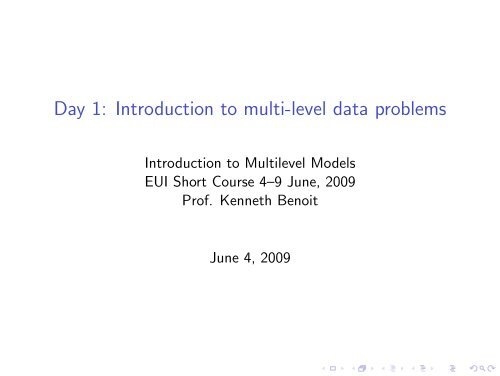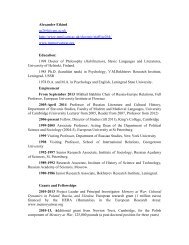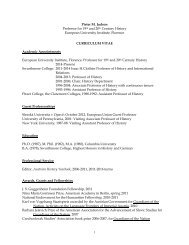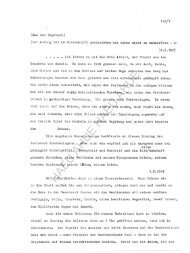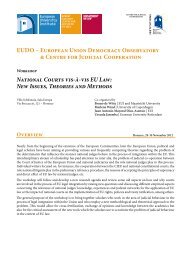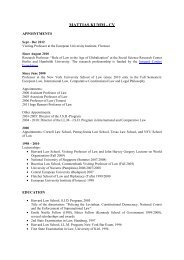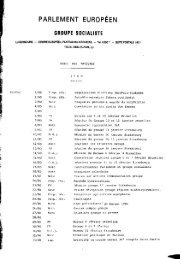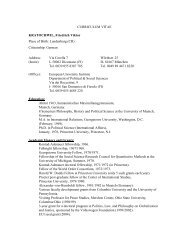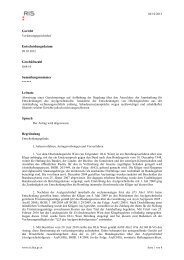Day 1: Introduction to multi-level data problems
Day 1: Introduction to multi-level data problems
Day 1: Introduction to multi-level data problems
You also want an ePaper? Increase the reach of your titles
YUMPU automatically turns print PDFs into web optimized ePapers that Google loves.
<strong>Day</strong> 1: <strong>Introduction</strong> <strong>to</strong> <strong>multi</strong>-<strong>level</strong> <strong>data</strong> <strong>problems</strong><br />
<strong>Introduction</strong> <strong>to</strong> Multi<strong>level</strong> Models<br />
EUI Short Course 4–9 June, 2009<br />
Prof. Kenneth Benoit<br />
June 4, 2009
Course logistics and overview<br />
◮ Purpose of the course<br />
◮ introduc<strong>to</strong>ry<br />
◮ basic mathematical understanding of MLMs<br />
◮ applied, emphasis on Stata<br />
◮ <strong>Day</strong> 5 covers a few non-linear models
Course logistics and overview<br />
◮ Purpose of the course<br />
◮ introduc<strong>to</strong>ry<br />
◮ basic mathematical understanding of MLMs<br />
◮ applied, emphasis on Stata<br />
◮ <strong>Day</strong> 5 covers a few non-linear models<br />
◮ What we will not do<br />
◮ work with really complicated <strong>multi</strong>-<strong>level</strong> structures<br />
◮ deal with estimation issues<br />
◮ use Bayesian methods
Course logistics and overview<br />
◮ Purpose of the course<br />
◮ introduc<strong>to</strong>ry<br />
◮ basic mathematical understanding of MLMs<br />
◮ applied, emphasis on Stata<br />
◮ <strong>Day</strong> 5 covers a few non-linear models<br />
◮ What we will not do<br />
◮ work with really complicated <strong>multi</strong>-<strong>level</strong> structures<br />
◮ deal with estimation issues<br />
◮ use Bayesian methods<br />
◮ Further caveats
Course logistics and overview<br />
◮ Purpose of the course<br />
◮ introduc<strong>to</strong>ry<br />
◮ basic mathematical understanding of MLMs<br />
◮ applied, emphasis on Stata<br />
◮ <strong>Day</strong> 5 covers a few non-linear models<br />
◮ What we will not do<br />
◮ work with really complicated <strong>multi</strong>-<strong>level</strong> structures<br />
◮ deal with estimation issues<br />
◮ use Bayesian methods<br />
◮ Further caveats<br />
◮ Texts and how <strong>to</strong> use them<br />
◮ Software and <strong>data</strong>sets<br />
◮ Homework format, timing<br />
◮ Overview of other course logistics
What is <strong>multi</strong><strong>level</strong> <strong>data</strong>?<br />
◮ Multi<strong>level</strong> <strong>data</strong> comes from a <strong>data</strong> structure in the population<br />
that is hierarchical, with sample <strong>data</strong> consisting of a<br />
<strong>multi</strong>stage sample from this population
What is <strong>multi</strong><strong>level</strong> <strong>data</strong>?<br />
◮ Multi<strong>level</strong> <strong>data</strong> comes from a <strong>data</strong> structure in the population<br />
that is hierarchical, with sample <strong>data</strong> consisting of a<br />
<strong>multi</strong>stage sample from this population<br />
◮ The classic example is schools and pupils: first we take a<br />
sample of schools, then sample pupils within each school
What is <strong>multi</strong><strong>level</strong> <strong>data</strong>?<br />
◮ Multi<strong>level</strong> <strong>data</strong> comes from a <strong>data</strong> structure in the population<br />
that is hierarchical, with sample <strong>data</strong> consisting of a<br />
<strong>multi</strong>stage sample from this population<br />
◮ The classic example is schools and pupils: first we take a<br />
sample of schools, then sample pupils within each school<br />
◮ We would then say that pupils are nested within schools
What is <strong>multi</strong><strong>level</strong> <strong>data</strong>?<br />
◮ Multi<strong>level</strong> <strong>data</strong> comes from a <strong>data</strong> structure in the population<br />
that is hierarchical, with sample <strong>data</strong> consisting of a<br />
<strong>multi</strong>stage sample from this population<br />
◮ The classic example is schools and pupils: first we take a<br />
sample of schools, then sample pupils within each school<br />
◮ We would then say that pupils are nested within schools<br />
◮ Other examples:<br />
◮ individuals nested within countries (survey <strong>data</strong>)<br />
◮ experts nested within countries (expert survey <strong>data</strong>)<br />
◮ coded documents nested within coders (Comparative<br />
Manifes<strong>to</strong> Project)<br />
◮ political parties within national contexts
What is <strong>multi</strong><strong>level</strong> <strong>data</strong>?<br />
◮ Multi<strong>level</strong> <strong>data</strong> comes from a <strong>data</strong> structure in the population<br />
that is hierarchical, with sample <strong>data</strong> consisting of a<br />
<strong>multi</strong>stage sample from this population<br />
◮ The classic example is schools and pupils: first we take a<br />
sample of schools, then sample pupils within each school<br />
◮ We would then say that pupils are nested within schools<br />
◮ Other examples:<br />
◮ individuals nested within countries (survey <strong>data</strong>)<br />
◮ experts nested within countries (expert survey <strong>data</strong>)<br />
◮ coded documents nested within coders (Comparative<br />
Manifes<strong>to</strong> Project)<br />
◮ political parties within national contexts<br />
◮ Variables may vary at either <strong>level</strong>
What is <strong>multi</strong><strong>level</strong> <strong>data</strong>?<br />
◮ Multi<strong>level</strong> <strong>data</strong> comes from a <strong>data</strong> structure in the population<br />
that is hierarchical, with sample <strong>data</strong> consisting of a<br />
<strong>multi</strong>stage sample from this population<br />
◮ The classic example is schools and pupils: first we take a<br />
sample of schools, then sample pupils within each school<br />
◮ We would then say that pupils are nested within schools<br />
◮ Other examples:<br />
◮ individuals nested within countries (survey <strong>data</strong>)<br />
◮ experts nested within countries (expert survey <strong>data</strong>)<br />
◮ coded documents nested within coders (Comparative<br />
Manifes<strong>to</strong> Project)<br />
◮ political parties within national contexts<br />
◮ Variables may vary at either <strong>level</strong><br />
◮ Basic terminology: lowest <strong>level</strong> is Level 1, higher is Level 2
What is <strong>multi</strong><strong>level</strong> <strong>data</strong>?<br />
◮ Multi<strong>level</strong> <strong>data</strong> comes from a <strong>data</strong> structure in the population<br />
that is hierarchical, with sample <strong>data</strong> consisting of a<br />
<strong>multi</strong>stage sample from this population<br />
◮ The classic example is schools and pupils: first we take a<br />
sample of schools, then sample pupils within each school<br />
◮ We would then say that pupils are nested within schools<br />
◮ Other examples:<br />
◮ individuals nested within countries (survey <strong>data</strong>)<br />
◮ experts nested within countries (expert survey <strong>data</strong>)<br />
◮ coded documents nested within coders (Comparative<br />
Manifes<strong>to</strong> Project)<br />
◮ political parties within national contexts<br />
◮ Variables may vary at either <strong>level</strong><br />
◮ Basic terminology: lowest <strong>level</strong> is Level 1, higher is Level 2<br />
◮ Response variables (Y ) always vary at the lowest <strong>level</strong>
What is <strong>multi</strong><strong>level</strong> <strong>data</strong>?<br />
◮ Multi<strong>level</strong> <strong>data</strong> comes from a <strong>data</strong> structure in the population<br />
that is hierarchical, with sample <strong>data</strong> consisting of a<br />
<strong>multi</strong>stage sample from this population<br />
◮ The classic example is schools and pupils: first we take a<br />
sample of schools, then sample pupils within each school<br />
◮ We would then say that pupils are nested within schools<br />
◮ Other examples:<br />
◮ individuals nested within countries (survey <strong>data</strong>)<br />
◮ experts nested within countries (expert survey <strong>data</strong>)<br />
◮ coded documents nested within coders (Comparative<br />
Manifes<strong>to</strong> Project)<br />
◮ political parties within national contexts<br />
◮ Variables may vary at either <strong>level</strong><br />
◮ Basic terminology: lowest <strong>level</strong> is Level 1, higher is Level 2<br />
◮ Response variables (Y ) always vary at the lowest <strong>level</strong>
The structure of <strong>multi</strong><strong>level</strong> <strong>data</strong><br />
5<br />
individuals (micro-units) are sampled from naturally<br />
occurring groups (macro-units).<br />
Population<br />
Group 1 Group 2<br />
Case 1 Case 2 … Case n1 Case 1 Case 2 … Case n2 …<br />
Group J<br />
In hierarchical <strong>data</strong> structures, there are (at least) two <strong>level</strong>s of sampling. Macro-units (fo<br />
groups) are sampled and then <strong>multi</strong>ple micro-units (for example, individuals) are sample<br />
macro-unit.<br />
We will typically refer <strong>to</strong> these two <strong>level</strong>s of sampling as Level 1 and Level 2, respective<br />
A common example of hierarchically structured <strong>data</strong> comes from the education field: stu<br />
within classrooms, which in turn might be nested within schools. Another example from<br />
is that <strong>multi</strong>ple patients may be seen by the same physician.<br />
Other examples of hierarchically structured <strong>data</strong> include these:
The structure of <strong>multi</strong><strong>level</strong> <strong>data</strong><br />
5<br />
individuals (micro-units) are sampled from naturally<br />
occurring groups (macro-units).<br />
Population<br />
Group 1 Group 2<br />
Case 1 Case 2 … Case n1 Case 1 Case 2 … Case n2 …<br />
Group J<br />
◮ a variation on this is longitudinal <strong>data</strong> structure, where the <strong>level</strong> 1<br />
In hierarchical variable is <strong>data</strong> anstructures, observation there forare a given (at least) time, two and <strong>level</strong>s theof <strong>level</strong> sampling. 2 variable Macro-units is (fo<br />
groups)<br />
a subject<br />
are sampled and then <strong>multi</strong>ple micro-units (for example, individuals) are sample<br />
macro-unit.<br />
We will typically refer <strong>to</strong> these two <strong>level</strong>s of sampling as Level 1 and Level 2, respective<br />
A common example of hierarchically structured <strong>data</strong> comes from the education field: stu<br />
within classrooms, which in turn might be nested within schools. Another example from<br />
is that <strong>multi</strong>ple patients may be seen by the same physician.<br />
Other examples of hierarchically structured <strong>data</strong> include these:
The structure of <strong>multi</strong><strong>level</strong> <strong>data</strong><br />
5<br />
individuals (micro-units) are sampled from naturally<br />
occurring groups (macro-units).<br />
Population<br />
Group 1 Group 2<br />
Case 1 Case 2 … Case n1 Case 1 Case 2 … Case n2 …<br />
Group J<br />
◮ a variation on this is longitudinal <strong>data</strong> structure, where the <strong>level</strong> 1<br />
In hierarchical variable is <strong>data</strong> anstructures, observation there forare a given (at least) time, two and <strong>level</strong>s theof <strong>level</strong> sampling. 2 variable Macro-units is (fo<br />
groups)<br />
a subject<br />
are sampled and then <strong>multi</strong>ple micro-units (for example, individuals) are sample<br />
macro-unit.<br />
◮ nesting may be unintentional: for instance we could have policy<br />
We will categories typically from refer <strong>to</strong> manifes<strong>to</strong>s these two (<strong>level</strong> <strong>level</strong>s of 1) sampling coded byas coder Level (<strong>level</strong> 1 and Level 2); or2,<br />
respective<br />
survey respondents (<strong>level</strong> 1) nested within interviewer (<strong>level</strong> 2)<br />
A common example of hierarchically structured <strong>data</strong> comes from the education field: stu<br />
within classrooms, which in turn might be nested within schools. Another example from<br />
is that <strong>multi</strong>ple patients may be seen by the same physician.<br />
Other examples of hierarchically structured <strong>data</strong> include these:
The structure of <strong>multi</strong><strong>level</strong> <strong>data</strong><br />
5<br />
individuals (micro-units) are sampled from naturally<br />
occurring groups (macro-units).<br />
Population<br />
Group 1 Group 2<br />
Case 1 Case 2 … Case n1 Case 1 Case 2 … Case n2 …<br />
Group J<br />
◮ a variation on this is longitudinal <strong>data</strong> structure, where the <strong>level</strong> 1<br />
In hierarchical variable is <strong>data</strong> anstructures, observation there forare a given (at least) time, two and <strong>level</strong>s theof <strong>level</strong> sampling. 2 variable Macro-units is (fo<br />
groups)<br />
a subject<br />
are sampled and then <strong>multi</strong>ple micro-units (for example, individuals) are sample<br />
macro-unit.<br />
◮ nesting may be unintentional: for instance we could have policy<br />
We will categories typically from refer <strong>to</strong> manifes<strong>to</strong>s these two (<strong>level</strong> <strong>level</strong>s of 1) sampling coded byas coder Level (<strong>level</strong> 1 and Level 2); or2,<br />
respective<br />
survey respondents (<strong>level</strong> 1) nested within interviewer (<strong>level</strong> 2)<br />
A common example of hierarchically structured <strong>data</strong> comes from the education field: stu<br />
◮ terminology may vary — here we refer <strong>to</strong> <strong>multi</strong><strong>level</strong> models<br />
within classrooms, which in turn might be nested within schools. Another example from<br />
is that<br />
generically<br />
<strong>multi</strong>ple patients<br />
but terms<br />
may be<br />
found<br />
seen<br />
in<br />
by<br />
the<br />
the<br />
literature<br />
same physician.<br />
include: variance<br />
components models, random-coefficients models and random-effects<br />
Other models, examples (general) of hierarchically mixed models, structured and <strong>data</strong> hierarchical include these: linear models
Why would special models be needed for <strong>multi</strong><strong>level</strong> <strong>data</strong>?<br />
◮ The usual assumptions for causal inference from regression<br />
models is that individual observations are independent<br />
◮ With nested structures this may not be the case: the<br />
correlation between observations within a common unit will be<br />
higher than the average correlation of observations between<br />
units<br />
◮ Consequence is that we will underestimate the uncertainty of<br />
causal effects from pooled estimates
Why would special models be needed for <strong>multi</strong><strong>level</strong> <strong>data</strong>?<br />
◮ The usual assumptions for causal inference from regression<br />
models is that individual observations are independent<br />
◮ With nested structures this may not be the case: the<br />
correlation between observations within a common unit will be<br />
higher than the average correlation of observations between<br />
units<br />
◮ Consequence is that we will underestimate the uncertainty of<br />
causal effects from pooled estimates<br />
◮ In addition, only <strong>multi</strong><strong>level</strong> models can help us separate<br />
within-unit from between-unit effects, especially the different<br />
average effects and the different effects of covariates
The ecological fallacy<br />
◮ The ecological fallacy refers <strong>to</strong> the fallacy of inferring<br />
individual behavior from aggregate <strong>data</strong> – in our context,<br />
inferring Level 1 relationships based on Level 2 units
The ecological fallacy<br />
◮ The ecological fallacy refers <strong>to</strong> the fallacy of inferring<br />
individual behavior from aggregate <strong>data</strong> – in our context,<br />
inferring Level 1 relationships based on Level 2 units<br />
◮ Arises when <strong>level</strong> 2 variables and <strong>level</strong> 1 variables reflect<br />
different causal processes
The ecological fallacy<br />
◮ The ecological fallacy refers <strong>to</strong> the fallacy of inferring<br />
individual behavior from aggregate <strong>data</strong> – in our context,<br />
inferring Level 1 relationships based on Level 2 units<br />
◮ Arises when <strong>level</strong> 2 variables and <strong>level</strong> 1 variables reflect<br />
different causal processes<br />
◮ originally from Robinson (1950) who studied the relationship<br />
between literacy and race in the US. The correlation between<br />
mean literacy rates and mean proportions of the black<br />
population was 0.95, but the individual-<strong>level</strong> correlation<br />
ignoring the grouping was just is 0.20
The ecological fallacy<br />
◮ The ecological fallacy refers <strong>to</strong> the fallacy of inferring<br />
individual behavior from aggregate <strong>data</strong> – in our context,<br />
inferring Level 1 relationships based on Level 2 units<br />
◮ Arises when <strong>level</strong> 2 variables and <strong>level</strong> 1 variables reflect<br />
different causal processes<br />
◮ originally from Robinson (1950) who studied the relationship<br />
between literacy and race in the US. The correlation between<br />
mean literacy rates and mean proportions of the black<br />
population was 0.95, but the individual-<strong>level</strong> correlation<br />
ignoring the grouping was just is 0.20<br />
◮ A problem in many political research questions, esp. voting<br />
behavior inferred from aggregated results
The a<strong>to</strong>mistic fallacy<br />
◮ The a<strong>to</strong>mistic fallacy (aka individualistic fallacy) may occur<br />
when drawing inferences about group-<strong>level</strong> relationships from<br />
individual-<strong>level</strong> <strong>data</strong>
The a<strong>to</strong>mistic fallacy<br />
◮ The a<strong>to</strong>mistic fallacy (aka individualistic fallacy) may occur<br />
when drawing inferences about group-<strong>level</strong> relationships from<br />
individual-<strong>level</strong> <strong>data</strong><br />
◮ Arises because individual-<strong>level</strong> associations associations may<br />
differ of those at the group <strong>level</strong>
The a<strong>to</strong>mistic fallacy<br />
◮ The a<strong>to</strong>mistic fallacy (aka individualistic fallacy) may occur<br />
when drawing inferences about group-<strong>level</strong> relationships from<br />
individual-<strong>level</strong> <strong>data</strong><br />
◮ Arises because individual-<strong>level</strong> associations associations may<br />
differ of those at the group <strong>level</strong><br />
◮ Example: we might find that individual income is positively<br />
associated with decreased mortality from heart disease. From<br />
this we should not infer, howeer, that at the country <strong>level</strong>,<br />
increasing per capita income is associated with decreasing<br />
heart disease mortality. In fact, across countries we might<br />
actually increase heart disease mortality by increasing income.
Stata and “robust” clustered standard errors”<br />
◮ One method of correcting for the effect of clusters is <strong>to</strong><br />
specify the vce(cluster clustvar) as an option <strong>to</strong><br />
regression commands
Stata and “robust” clustered standard errors”<br />
◮ One method of correcting for the effect of clusters is <strong>to</strong><br />
specify the vce(cluster clustvar) as an option <strong>to</strong><br />
regression commands<br />
◮ This relaxes the requirement that the errors be independent,<br />
by allowing them <strong>to</strong> be correlated within each cluster group
Stata and “robust” clustered standard errors”<br />
◮ One method of correcting for the effect of clusters is <strong>to</strong><br />
specify the vce(cluster clustvar) as an option <strong>to</strong><br />
regression commands<br />
◮ This relaxes the requirement that the errors be independent,<br />
by allowing them <strong>to</strong> be correlated within each cluster group<br />
◮ The correction only affects the standard errors, not the<br />
estimated coefficients, since it operates only on the<br />
variance-covariance matrix
Stata and “robust” clustered standard errors”<br />
◮ One method of correcting for the effect of clusters is <strong>to</strong><br />
specify the vce(cluster clustvar) as an option <strong>to</strong><br />
regression commands<br />
◮ This relaxes the requirement that the errors be independent,<br />
by allowing them <strong>to</strong> be correlated within each cluster group<br />
◮ The correction only affects the standard errors, not the<br />
estimated coefficients, since it operates only on the<br />
variance-covariance matrix<br />
◮ This will not get at the core issues of interest for <strong>multi</strong><strong>level</strong><br />
models, which have <strong>to</strong> do with separating between-group<br />
effects from within-group effects, and especially not the<br />
provision for random intercepts and or slopes
The organization of <strong>multi</strong><strong>level</strong> <strong>data</strong><br />
◮ Multi<strong>level</strong> <strong>data</strong> are distinguished by their organization<br />
according <strong>to</strong> <strong>multi</strong><strong>level</strong> identifying units. Examples:<br />
◮ constituency ID<br />
◮ country ID<br />
◮ school ID
The organization of <strong>multi</strong><strong>level</strong> <strong>data</strong><br />
◮ Multi<strong>level</strong> <strong>data</strong> are distinguished by their organization<br />
according <strong>to</strong> <strong>multi</strong><strong>level</strong> identifying units. Examples:<br />
◮ constituency ID<br />
◮ country ID<br />
◮ school ID<br />
◮ There are two basic formats for organizing <strong>data</strong> that are<br />
clustered by identifying units:
The organization of <strong>multi</strong><strong>level</strong> <strong>data</strong><br />
◮ Multi<strong>level</strong> <strong>data</strong> are distinguished by their organization<br />
according <strong>to</strong> <strong>multi</strong><strong>level</strong> identifying units. Examples:<br />
◮ constituency ID<br />
◮ country ID<br />
◮ school ID<br />
◮ There are two basic formats for organizing <strong>data</strong> that are<br />
clustered by identifying units:<br />
wide format two columns of <strong>data</strong> contain the same<br />
information, distinguished by different <strong>level</strong>s
The organization of <strong>multi</strong><strong>level</strong> <strong>data</strong><br />
◮ Multi<strong>level</strong> <strong>data</strong> are distinguished by their organization<br />
according <strong>to</strong> <strong>multi</strong><strong>level</strong> identifying units. Examples:<br />
◮ constituency ID<br />
◮ country ID<br />
◮ school ID<br />
◮ There are two basic formats for organizing <strong>data</strong> that are<br />
clustered by identifying units:<br />
wide format two columns of <strong>data</strong> contain the same<br />
information, distinguished by different <strong>level</strong>s<br />
long format different <strong>level</strong>s are themselves variables (in their<br />
own columns
Zen and the art of reshapeing<br />
◮ some things cannot be done in long format. For instance if we<br />
want <strong>to</strong> plot one set of scores against another, e.g. taxes v.<br />
spending versus social dimension from the expert surveys
Zen and the art of reshapeing<br />
◮ some things cannot be done in long format. For instance if we<br />
want <strong>to</strong> plot one set of scores against another, e.g. taxes v.<br />
spending versus social dimension from the expert surveys<br />
◮ For this we need the wide format, where each dimension forms<br />
a separate variable and the identifier defines a unique row
Zen and the art of reshapeing<br />
◮ some things cannot be done in long format. For instance if we<br />
want <strong>to</strong> plot one set of scores against another, e.g. taxes v.<br />
spending versus social dimension from the expert surveys<br />
◮ For this we need the wide format, where each dimension forms<br />
a separate variable and the identifier defines a unique row<br />
◮ To convert from long <strong>to</strong> wide (and vice versa), we need the<br />
reshape command
Zen and the art of reshapeing<br />
◮ some things cannot be done in long format. For instance if we<br />
want <strong>to</strong> plot one set of scores against another, e.g. taxes v.<br />
spending versus social dimension from the expert surveys<br />
◮ For this we need the wide format, where each dimension forms<br />
a separate variable and the identifier defines a unique row<br />
◮ To convert from long <strong>to</strong> wide (and vice versa), we need the<br />
reshape command<br />
◮ The key <strong>to</strong> using reshape is <strong>to</strong> determine what the logical<br />
observation i is and the subobservation j that will be used <strong>to</strong><br />
organize the <strong>data</strong>
Zen and the art of reshapeing continued<br />
(wide form)<br />
i ....... x_ij ........<br />
id sex inc80 inc81 inc82<br />
-------------------------------<br />
1 0 5000 5500 6000<br />
2 1 2000 2200 3300<br />
3 0 3000 2000 1000<br />
(long form)<br />
i j x_ij<br />
id year sex inc<br />
-----------------------<br />
1 80 0 5000<br />
1 81 0 5500<br />
1 82 0 6000<br />
2 80 1 2000<br />
2 81 1 2200<br />
2 82 1 3300<br />
3 80 0 3000<br />
3 81 0 2000<br />
3 82 0 1000<br />
Given this <strong>data</strong>, you could use reshape <strong>to</strong> convert from one form <strong>to</strong> the other:<br />
. reshape long inc, i(id) j(year) (goes from <strong>to</strong>p-form <strong>to</strong> bot<strong>to</strong>m)<br />
. reshape wide inc, i(id) j(year) (goes from bot<strong>to</strong>m-form <strong>to</strong> <strong>to</strong>p)
Example of <strong>multi</strong><strong>level</strong> <strong>data</strong>: Benoit and Marsh (2008)<br />
. use dail2002spending<br />
(Irish Dail 2002 from Benoit and Marsh 2008)<br />
. list constID constituency namelast party votes1st incumb m spent in 6/28, clean<br />
constID constituency namelast party votes1st incumb m spent<br />
6. 1 Carlow Kilkenny McGuinness ff 9343 1 5 19648.3<br />
7. 1 Carlow Kilkenny Nolan ff 8711 0 5 24100.27<br />
8. 1 Carlow Kilkenny Nolan ind 335 0 5 6544.23<br />
9. 1 Carlow Kilkenny O’Brien lab 3732 0 5 8404.43<br />
10. 1 Carlow Kilkenny Townsend lab 4272 0 5 10658.21<br />
11. 1 Carlow Kilkenny White gp 4961 0 5 12110.11<br />
12. 2 Cavan Monaghan Boyland fg 4819 1 5 11217.01<br />
13. 2 Cavan Monaghan Brennan ind 1026 0 5 17196.73<br />
14. 2 Cavan Monaghan Connolly ind 7722 0 5 17934.79<br />
15. 2 Cavan Monaghan Crawford fg 6113 1 5 11124<br />
16. 2 Cavan Monaghan Cullen lab 550 0 5 8756.67<br />
17. 2 Cavan Monaghan Gallagher ff 3731 0 5 20122.19<br />
18. 2 Cavan Monaghan Martin ind 1943 0 5 34542.73<br />
19. 2 Cavan Monaghan McCabe gp 1100 0 5 10699.87<br />
20. 2 Cavan Monaghan McCaughey pd 1131 0 5 30573.12<br />
21. 2 Cavan Monaghan O Caolain sf 10832 1 5 28953.32<br />
22. 2 Cavan Monaghan O’Hanlon ff 7204 1 5 21483.37<br />
23. 2 Cavan Monaghan O’Reilly fg 4639 0 5 12839.2<br />
24. 2 Cavan Monaghan Smith csp 358 0 5 3141.27<br />
25. 2 Cavan Monaghan Smith ff 10679 1 5 22383.53<br />
26. 3 Clare Breen fg 4541 0 4 11687.46<br />
27. 3 Clare Breen ind 9721 0 4 11974.15<br />
28. 3 Clare Carey fg 4015 1 4 14195.46
Benoit and Marsh (2008) example continued<br />
. desc<br />
Contains <strong>data</strong> from dail2002spending.dta<br />
obs: 463 Irish Dail 2002 from Benoit and Marsh 2008<br />
vars: 10 18 May 2009 17:45<br />
size: 26,854 (99.9% of memory free)<br />
----------------------------------------------------------------------------------------s<strong>to</strong>rage<br />
display value<br />
variable name type format label variable label<br />
----------------------------------------------------------------------------------------constID<br />
byte %9.0g Constituency Numeric ID<br />
constituency str20 %20s Candidate’s constituency<br />
namelast str15 %15s Candidate’s last name<br />
party byte %8.0g party_e Candidate’s party label<br />
votes1st int %9.0g First preference votes 2002<br />
incumb byte %9.0g Incumbency status 1/0<br />
wonseat byte %9.0g Candidate won a seat 1/0<br />
m byte %9.0g District magnitude<br />
elec<strong>to</strong>rate float %9.0g Registered voters in constituency<br />
spent float %9.0g Total spending<br />
-----------------------------------------------------------------------------------------<br />
Sorted by: constID namelast<br />
Constitituency-<strong>level</strong> m, elec<strong>to</strong>rate<br />
Candidate-<strong>level</strong> namelast, votes1st, incumb, wonseat, spent, party
Benoit and Marsh (2008) example continued<br />
. desc<br />
Contains <strong>data</strong> from dail2002spending.dta<br />
obs: 463 Irish Dail 2002 from Benoit and Marsh 2008<br />
vars: 10 18 May 2009 17:45<br />
size: 26,854 (99.9% of memory free)<br />
----------------------------------------------------------------------------------------s<strong>to</strong>rage<br />
display value<br />
variable name type format label variable label<br />
----------------------------------------------------------------------------------------constID<br />
byte %9.0g Constituency Numeric ID<br />
constituency str20 %20s Candidate’s constituency<br />
namelast str15 %15s Candidate’s last name<br />
party byte %8.0g party_e Candidate’s party label<br />
votes1st int %9.0g First preference votes 2002<br />
incumb byte %9.0g Incumbency status 1/0<br />
wonseat byte %9.0g Candidate won a seat 1/0<br />
m byte %9.0g District magnitude<br />
elec<strong>to</strong>rate float %9.0g Registered voters in constituency<br />
spent float %9.0g Total spending<br />
-----------------------------------------------------------------------------------------<br />
Sorted by: constID namelast<br />
Constitituency-<strong>level</strong> m, elec<strong>to</strong>rate<br />
Candidate-<strong>level</strong> namelast, votes1st, incumb, wonseat, spent, party<br />
(and we could view party as having a special status)
Long v. wide <strong>data</strong> format: PPMD example<br />
. use PPMD_detail, clear<br />
(Party Policy in Modern Democracies, Kenneth Benoit and Michael Laver)<br />
. sample 20, count<br />
(206945 observations deleted)<br />
. list Country Party Dimension Scale Survey_Label_ID Score Vote_Share Election_Date, clean<br />
Country Party Dimension Scale Survey~D Score Vote_S~e Electi~e<br />
1. SE MP Taxes v. Spending Position 408 11 4.6 2002<br />
2. ES CiU Taxes v. Spending Position 191 12 3.2 2004<br />
3. SE M EU: Peacekeeping Position 892 5 15.2 2002<br />
4. DE CDU/CSU EU: Peacekeeping Importance 1689 3 38.51 2002<br />
5. MD PDAM Environment Importance 12 6 1.9 2001<br />
6. SI SNS Urban-Rural Importance 44 16 4.4 2000<br />
7. NO KrF NATO/Peacekeeping Position 74 8 12.5 2001<br />
8. FR UDF Taxes v. Spending Importance 16 14 4.8 2002<br />
9. SR DSS Left-Right Position 1 13 18 2003<br />
10. CA LPC Sympathy Position 820 17 40.8 2000<br />
11. JP JCP Defense policy Importance 3 5 7.7 2003<br />
12. CA GPC Sympathy Position 437 7 .8 2000<br />
13. RO PD Social Position 574 6 7.03 2000<br />
14. HU MUNKS Media Freedom Importance 823 19 2.8 2002<br />
15. IL Merz Palestinian State Importance 543 20 5.2 2003<br />
16. DE GRU EU: Peacekeeping Importance 1262 13 8.6 2002<br />
17. IT SDI Deregulation Importance 120 14 1.1 2001<br />
18. BE PS Environment Position 547 10 13 2003<br />
19. IT UDC EU: Accountability Importance 189 12 3.2 2001<br />
20. CZ SZ Social Position 31 12 2.36 2002
Long v. wide <strong>data</strong> format: PPMD example<br />
◮ The PPMD <strong>data</strong>set is organized as long <strong>data</strong>, where the basic<br />
unit of variation is the Score variable
Long v. wide <strong>data</strong> format: PPMD example<br />
◮ The PPMD <strong>data</strong>set is organized as long <strong>data</strong>, where the basic<br />
unit of variation is the Score variable<br />
◮ Score represents the placement on a 1–20 point scale of<br />
either the left-right location or the low–high importance
Long v. wide <strong>data</strong> format: PPMD example<br />
◮ The PPMD <strong>data</strong>set is organized as long <strong>data</strong>, where the basic<br />
unit of variation is the Score variable<br />
◮ Score represents the placement on a 1–20 point scale of<br />
either the left-right location or the low–high importance<br />
◮ The different variables are:<br />
Country a code designating the country<br />
Party a country-specific alphanumeric identifier for<br />
party<br />
Dimension one of 40-odd policy dimensions<br />
Scale either Position or Importance<br />
Survey Label ID country-specific respondent ID
Long v. wide <strong>data</strong> format: PPMD example<br />
◮ The PPMD <strong>data</strong>set is organized as long <strong>data</strong>, where the basic<br />
unit of variation is the Score variable<br />
◮ Score represents the placement on a 1–20 point scale of<br />
either the left-right location or the low–high importance<br />
◮ The different variables are:<br />
Country a code designating the country<br />
Party a country-specific alphanumeric identifier for<br />
party<br />
Dimension one of 40-odd policy dimensions<br />
Scale either Position or Importance<br />
Survey Label ID country-specific respondent ID<br />
◮ This is a useful way <strong>to</strong> s<strong>to</strong>re the <strong>data</strong>, but may not be useful<br />
for analyzing it, although this depends
Long v. wide <strong>data</strong> format: PPMD example continued<br />
For <strong>data</strong> analysis based on tables, the long format is required.<br />
Example:<br />
. use PPMD_detail, clear<br />
(Party Policy in Modern Democracies, Kenneth Benoit and Michael Laver)<br />
. table Party Dimension if Country=="IT":cntryLab & Scale==1 & Dimension
Long v. wide <strong>data</strong> format: PPMD example continued<br />
. table Country Dimension if Dimension60<br />
-------------------------------------------------------------------<br />
Country | Policy dimension<br />
name | Taxes v. Spending Social EU joining<br />
----------+--------------------------------------------------------<br />
GR | 127 128<br />
IS | 144 144<br />
IE | 626 632<br />
IL | 668 682<br />
IT | 1,189 1,196<br />
LU | 48 47<br />
MT | 35 38 38<br />
NL | 387 387<br />
NZ | 301<br />
NI | 152 154<br />
NO | 330 333 336<br />
PT | 246 243<br />
ES | 753 751<br />
SE | 937 936<br />
CH | 934 956 897<br />
TR | 412 411 423<br />
US | 662 662<br />
EU | 273 287<br />
JP | 696 696<br />
-------------------------------------------------------------------
Long v. wide <strong>data</strong> format: PPMD example continued<br />
For <strong>data</strong> analysis based on tables, the long format is required.<br />
Example:<br />
. ttest Score if Dimension>13, by(Scale)<br />
Two-sample t test with equal variances<br />
------------------------------------------------------------------------------<br />
Group | Obs Mean Std. Err. Std. Dev. [95% Conf. Interval]<br />
---------+--------------------------------------------------------------------<br />
Position | 39587 10.65799 .0292697 5.823644 10.60062 10.71536<br />
Importan | 30031 12.98175 .0274553 4.75786 12.92794 13.03557<br />
---------+-------------------------------------------------------------------combined<br />
| 69618 11.66039 .0208877 5.511278 11.61945 11.70133<br />
---------+-------------------------------------------------------------------diff<br />
| -2.323758 .0412452 -2.404599 -2.242918<br />
-----------------------------------------------------------------------------diff<br />
= mean(Position) - mean(Importan) t = -56.3401<br />
Ho: diff = 0 degrees of freedom = 69616<br />
Ha: diff < 0 Ha: diff != 0 Ha: diff > 0<br />
Pr(T < t) = 0.0000 Pr(|T| > |t|) = 0.0000 Pr(T > t) = 1.0000
Reshape example with expert survey <strong>data</strong><br />
. reshape wide Score, i(Country Survey_Label_ID Party Vote_Share Scale) j(Dimension)<br />
(note: j = 1 2 3 4 5 6 7 8 9 10 11 12 13 14 15 16 17 18 19 20 21 22 23 24 25 26 27 28 29 30 31 32 33 34 35<br />
Data long -> wide<br />
-----------------------------------------------------------------------------<br />
Number of obs. 206970 -> 21029<br />
Number of variables 12 -> 50<br />
j variable (40 values) Dimension -> (dropped)<br />
xij variables:<br />
Score -> Score1 Score2 ... Score99<br />
-----------------------------------------------------------------------------<br />
. list Country Party Scale Survey_Label_ID Vote_Share Score1-Score4 in 1/10, clean<br />
Country Party Scale Survey~D Vote_S~e Score1 Score2 Score3 Score4<br />
1. AL PBDNJ Position 1 2.6 9 9 9 14<br />
2. AL PBDNJ Importance 1 2.6 4 1 3 17<br />
3. AL PD Position 1 19.36 12 9 15 17<br />
4. AL PD Importance 1 19.36 16 4 15 17<br />
5. AL PDr Position 1 5.1 13 9 15 17<br />
6. AL PDr Importance 1 5.1 16 6 15 17<br />
7. AL PLL Position 1 4.03 14 11 15 17<br />
8. AL PLL Importance 1 4.03 14 4 15 17<br />
9. AL PR Position 1 4.83 13 11 15 17<br />
10. AL PR Importance 1 4.83 16 4 16 17
Reshape example with expert survey <strong>data</strong><br />
. use PPMD_summary_day1, clear<br />
(Party Policy in Modern Democracies, K. Benoit and M. Laver, Summary Data)<br />
. reshape wide Mean, i(Country Party Scale) j(Dimension)<br />
(note: j = 1 2 3 4 5 6 7 8 9 10 11 12 13 14 15 16 17 18 19 20 21 22 23 24 25 26 27 28 29 30 31 32 33 36 37<br />
Data long -> wide<br />
-----------------------------------------------------------------------------<br />
Number of obs. 8106 -> 739<br />
Number of variables 8 -> 44<br />
j variable (38 values) Dimension -> (dropped)<br />
xij variables:<br />
Mean -> Mean1 Mean2 ... Mean99<br />
-----------------------------------------------------------------------------<br />
. graph twoway (qfitci Mean24 Mean13) (scatter Mean24 Mean13, msize(small) m(oh)) if Scale==1,<br />
> xtitle(Left-Right) ytitle(EU Integration) legend(off)
Reshape example with expert survey <strong>data</strong><br />
. use PPMD_summary_day1, clear<br />
(Party Policy in Modern Democracies, K. Benoit and M. Laver, Summary Data)<br />
. reshape wide Mean, i(Country Party Scale) j(Dimension)<br />
(note: j = 1 2 3 4 5 6 7 8 9 10 11 12 13 14 15 16 17 18 19 20 21 22 23 24 25 26 27 28 29 30 31 32 33 36 37<br />
Data long -> wide<br />
-----------------------------------------------------------------------------<br />
Number of obs. 8106 -> 739<br />
Number of variables 8 -> 44<br />
j variable (38 values) Dimension -> (dropped)<br />
xij variables:<br />
Mean -> Mean1 Mean2 ... Mean99<br />
-----------------------------------------------------------------------------<br />
. graph twoway (qfitci Mean24 Mean13) (scatter Mean24 Mean13, msize(small) m(oh)) if Scale==1,<br />
> xtitle(Left-Right) ytitle(EU Integration) legend(off)<br />
20<br />
05 510 10 15 20 EU Integration<br />
EU Integration<br />
005<br />
510 10 15 20 Left-Right<br />
0<br />
15<br />
EU Integration<br />
10<br />
5<br />
0<br />
0<br />
5<br />
10<br />
Left-Right<br />
15<br />
20
Introducing variance decomposition models<br />
◮ Standard model without covariates:<br />
yij = β + ξij
Introducing variance decomposition models<br />
◮ Standard model without covariates:<br />
yij = β + ξij<br />
◮ We can model the dependence within subjects j by splitting ξij in<strong>to</strong><br />
two components ζj and ɛij:<br />
yij = β + ζj + ɛij
Introducing variance decomposition models<br />
◮ Standard model without covariates:<br />
yij = β + ξij<br />
◮ We can model the dependence within subjects j by splitting ξij in<strong>to</strong><br />
two components ζj and ɛij:<br />
yij = β + ζj + ɛij<br />
◮ ζj represent <strong>level</strong>-2 effects, also known as “random intercepts”, with<br />
variance ψ:<br />
ζj ∼ N(0, ψ)
Introducing variance decomposition models<br />
◮ Standard model without covariates:<br />
yij = β + ξij<br />
◮ We can model the dependence within subjects j by splitting ξij in<strong>to</strong><br />
two components ζj and ɛij:<br />
yij = β + ζj + ɛij<br />
◮ ζj represent <strong>level</strong>-2 effects, also known as “random intercepts”, with<br />
variance ψ:<br />
ζj ∼ N(0, ψ)<br />
◮ ɛij are <strong>level</strong>-1 errors, with variance θ<br />
ɛij ∼ N(0, θ)
Introducing variance decomposition models<br />
◮ Standard model without covariates:<br />
yij = β + ξij<br />
◮ We can model the dependence within subjects j by splitting ξij in<strong>to</strong><br />
two components ζj and ɛij:<br />
yij = β + ζj + ɛij<br />
◮ ζj represent <strong>level</strong>-2 effects, also known as “random intercepts”, with<br />
variance ψ:<br />
ζj ∼ N(0, ψ)<br />
◮ ɛij are <strong>level</strong>-1 errors, with variance θ<br />
ɛij ∼ N(0, θ)<br />
◮ More complicated models will be explored later, such as random<br />
coefficients (involving β differences at <strong>level</strong>-2)


